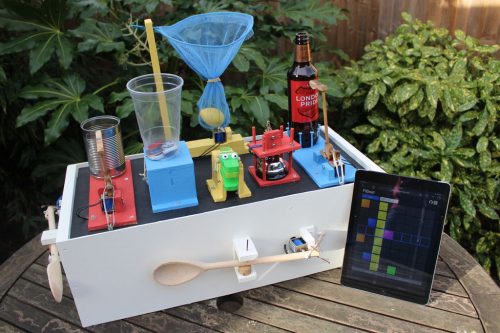

The Junk Drum Machine
source link: https://www.tuicool.com/articles/hit/fAbMNvn
Go to the source link to view the article. You can view the picture content, updated content and better typesetting reading experience. If the link is broken, please click the button below to view the snapshot at that time.

I do not really have any spare time. (Toddler, job, very demanding cat, lots of LEGO to tidy up.) If I did, I like to imagine that I’d come up with something like this to do with it.

Want to see this collection of junk animate? Scroll down for video.
From someone calling themselves Banjowise (let me know what your real name is in the comments, please, so I can credit you properly here!), here is a pile of junk turned into a weirdly compelling drum machine.
Mechanically speaking, this isn’t too complicated: just a set of solenoids triggered by a Raspberry Pi. The real clever is in the beauteous, browser-based step sequencer Banjowise has built to program the solenoids to wallop things in beautiful rhythm. And in the beauteous, skip-sourced tchotchkes that Banjowise has found for them to wallop. Generously, they’ve made full instructions on making your own available on Instructables. Use any bits and bobs you can get your hands on if old piano hammers and crocodile castanets are not part of the detritus kicking around your house.
Warning: this video is weirdly compelling.
Automabeat – A Raspberry Pi Mechanical Robotic Junk Drum Machine
My Raspberry Pi based drum / percussion machine. Consisting of 8 12v solenoids, a relay, wooden spoons, a Fullers beer bottle, a crocodile maraca and a few other things. An Instructable on how to build your own is here: https://www.instructables.com/id/A-Raspberry-Pi-Powered-Junk-Drum-Machine/, or take a look at: http://www.banjowise.com/post/automabeat/
The sequencer is lovely: a gorgeously simple user interface that you can run on a tablet, your phone, or anything else with a browser (and it’s very easily adaptable to other projects). The web interface lets Python trigger the GPIO pins over web sockets. There’s a precompiled version available for people who’ve followed Banjowise’s comprehensive wiring instructions, but you can also get the source code from GitHub .

I think I’m getting good, but I can handle criticism.
We love it. Now please excuse me. I need a little while to search online for crocodile castanets.
Recommend
-
 6
6
Documentation for V-Drum Explorer All source code is in the Drums directory of the GitHub repo. This is not a MIDI sequencer or anything similar; it’s purely...
-
 6
6
V-Drum Explorer Blazor DemoLoading...
-
 11
11
Best drum sets TechnoBuffalo 2021 Studies show that playing the drums is a great workout of the brain, and it reduces stress and anxiety. For some, it may just be noise pollution! Choosing the right drum set can be a...
-
 11
11
5 Best Drum Seats of 2021 Bestseller No. 1 Donner Drum Throne Set, Height... Hi...
-
 10
10
-
 3
3
Jul 27, 2021 8 min read Drum Synthesis in JavaScript
-
 7
7
@ashutoshmishraAshutosh MishraFront-End Developer and Blogger at ClearprogrammerHey Everyone 👋, first things first, this project is part of the JavaSc...
-
 6
6
Hang Massive - Once Again - 2011 ( hang drum duo ) ( HD )52,822,993 viewsDec 29, 2011 Join Our 10 Yea...
-
 8
8
(a or not b)'s DRUM MACHINE v.1.0 NoiseCraft New Share...
-
 4
4
Looking for a drum machine app for macOS P pax-eterna
About Joyk
Aggregate valuable and interesting links.
Joyk means Joy of geeK